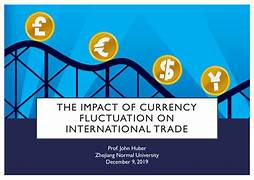Exploring the Effects of Exchange Rate Fluctuations on International Trade
Exchange rate fluctuations have a profound impact on international trade, influencing the cost of goods and services, the competitiveness of businesses, and the economic stability of nations. As global economies become increasingly interconnected, understanding the effects of exchange rate movements is critical for policymakers, businesses, and investors. This article explores the various dimensions of exchange rate fluctuations, their causes, and their implications for international trade.
Understanding Exchange Rates and Their Fluctuations
Exchange rates represent the value of one currency relative to another. For example, the exchange rate between the U.S. dollar (USD) and the euro (EUR) indicates how many euros one dollar can purchase. These rates fluctuate due to various factors, including:
- Supply and Demand: The foreign exchange market operates on supply and demand principles. If demand for a currency increases, its value rises relative to others.
- Interest Rates: Higher interest rates in a country attract foreign investment, increasing demand for that country’s currency and strengthening its value.
- Economic Indicators: Indicators like GDP growth, inflation rates, and employment figures influence investor confidence and currency valuation.
- Political Stability: Countries with stable political environments are more likely to attract foreign investment, leading to stronger currencies.
- Central Bank Policies: Actions such as quantitative easing or changes in interest rates by central banks directly affect exchange rates.
Positive Effects of Exchange Rate Fluctuations on Trade
- Boosting Exports:
- When a country’s currency depreciates, its goods and services become cheaper for foreign buyers. This price advantage can increase export volumes, benefiting domestic producers.
- Encouraging Foreign Investment:
- Depreciation can make domestic assets, such as real estate or stocks, more attractive to foreign investors, boosting the inflow of capital.
- Promoting Tourism:
- A weaker currency makes travel more affordable for foreign tourists, boosting the tourism industry and related sectors such as hospitality and retail.
Negative Effects of Exchange Rate Fluctuations on Trade
- Increased Import Costs:
- Currency depreciation makes imported goods and services more expensive, leading to higher production costs for businesses reliant on foreign raw materials. This can increase inflationary pressures.
- Uncertainty and Risk:
- Exchange rate volatility creates uncertainty, making it challenging for businesses to plan and price their products effectively. This can deter investment and trade.
- Trade Deficits:
- Currency appreciation, while beneficial for imports, can harm exports by making them more expensive for foreign buyers. This can lead to trade deficits and economic imbalances.
- Impact on Debt Repayment:
- Countries with significant foreign debt denominated in foreign currencies may find repayment more expensive when their currency depreciates, leading to economic strain.
Sector-Specific Impacts
- Manufacturing:
- Exchange rate fluctuations directly impact the cost of imported raw materials and components. For export-driven manufacturers, a weaker domestic currency can enhance competitiveness, while a stronger currency can erode profit margins.
- Agriculture:
- Agricultural exporters benefit from depreciation as their products become more affordable in international markets. However, reliance on imported fertilizers and equipment can offset these gains.
- Technology:
- Companies reliant on global supply chains face dual challenges: higher import costs due to currency depreciation and pricing pressures in competitive international markets.
- Retail:
- Retailers importing goods from abroad face higher costs during depreciation periods, which may be passed on to consumers through higher prices.
Case Studies: The Real-World Impact of Exchange Rate Fluctuations
- China’s Yuan Depreciation:
- China has strategically managed its currency to boost exports, making its products cheaper and more competitive globally. However, this has led to trade tensions, particularly with the U.S.
- Eurozone Volatility:
- The euro’s fluctuations against the U.S. dollar have affected trade within the European Union and with external partners, influencing export competitiveness and import costs.
- Emerging Markets:
- Countries like Turkey and Argentina have experienced severe currency devaluations, leading to inflation and reduced purchasing power. This has hurt their ability to engage in international trade effectively.
Managing the Risks of Exchange Rate Fluctuations
- Hedging Strategies:
- Businesses can use financial instruments such as futures, options, and forward contracts to mitigate the risks of currency fluctuations.
- Diversification:
- Companies operating in multiple markets can reduce their exposure to any single currency’s volatility.
- Pricing Adjustments:
- Firms can adopt flexible pricing strategies to account for currency fluctuations and maintain competitiveness.
- Government Policies:
- Governments can implement policies to stabilize exchange rates, such as intervening in forex markets or establishing currency pegs.
The Role of Technology and Innovation
Technological advancements have transformed how businesses and policymakers respond to exchange rate fluctuations. Real-time data analytics and AI-driven forecasting tools enable more accurate predictions, helping businesses and governments make informed decisions.
Blockchain and cryptocurrency also offer potential solutions to mitigate exchange rate risks by facilitating cross-border transactions without traditional currency conversions.
Conclusion
Exchange rate fluctuations play a pivotal role in shaping international trade dynamics. While they present opportunities to enhance export competitiveness and attract investment, they also pose significant risks, including higher import costs and economic uncertainty. To navigate these challenges, businesses must adopt robust risk management strategies, and policymakers must work towards stabilizing exchange rate movements.
Understanding and addressing the effects of exchange rate fluctuations is essential for fostering sustainable and equitable global trade. By leveraging technology, diversification, and strategic planning, stakeholders can mitigate risks and capitalize on the opportunities presented by an ever-evolving global economy.


